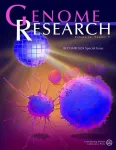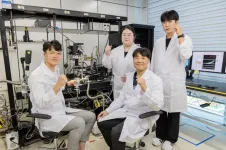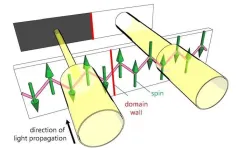(Press-News.org) [Vienna, October 11, 2024] – A new article highlights a critical issue in the One Health approach—an emerging global framework for tackling complex health challenges at the intersection of human, animal, and environmental health. In the article in The Lancet Planetary Health, scientists Amélie Desvars-Larrive and Fariba Karimi from the Complexity Science Hub (CSH) point out that One Health's current framework fails to explicitly address workforce diversity.
According to Desvars-Larrive and Karimi, true innovation in solving public health challenges requires not just an interdisciplinary approach but also a diverse workforce that reflects a range of human differences—including ethnic, gender, sexual orientation, race, nationality, and more.
The Multiple Facets of Diversity
“We usually think of diversity in One Health in terms of teams with experts from different knowledge areas,” explains Desvars-Larrive, who leads CSH’s research team on Health Across Species. “After meeting Fariba at CSH, I learned that diversity goes far beyond that,” says Desvars-Larrive, also a professor in Infectious Disease Epidemiology at the University of Veterinary Medicine Vienna.
“Diversity has multiple facets. As we argue here, those differences in terms of social constructs such as ethnicity, race, and sexual orientation, contribute to diverse lived experiences that are important when addressing complex health challenges,” says Karimi, who leads CSH's research team on Algorithmic Fairness.
“Such global challenges are often complex problems and to solve them we need a diverse group of people to examine the problem from different angles and bring a variety of perspectives and methods,” explains Karimi, also a professor of Social Data Science at Graz University of Technology.
In her research, Karimi explores a wide range of social problems and phenomena through computational social science. Her recent work addresses the emergence of biases and inequality in social networks, as well as the visibility of minorities.
Innovative and Creative Thinking
According to Desvars-Larrive and Karimi, diversity fosters creativity, reduces groupthink, and improves the quality of scientific research. “Teams that encompass a diverse mix of genders, sociocultural backgrounds, and perspectives, while fostering inclusiveness, tend to be more productive, more competitive, more innovative, and better equipped to find effective science-based solutions. Notably, diversity in teams enhances community participation, particularly when researching minority populations,” add the CSH scientists.
“CSH fosters interdisciplinary research and communication, which allowed me to chat with Amélie about this topic ultimately leading to this shared understanding and this publication, showing the importance of creating space for diverse views,” adds Karimi.
About the article
This correspondence article, titled "Beyond silos: integrating diversity for a stronger One Health," by Amélie Desvars-Larrive and Fariba Karimi was published in The Lancet Planetary Health and is available online.
About CSH
The Complexity Science Hub (CSH) is Europe’s research center for the study of complex systems. We derive meaning from data from a range of disciplines — economics, medicine, ecology, and the social sciences — as a basis for actionable solutions for a better world. Established in 2015, we have grown to over 70 researchers, driven by the increasing demand to gain a genuine understanding of the networks that underlie society, from healthcare to supply chains. Through our complexity science approaches linking physics, mathematics, and computational modeling with data and network science, we develop the capacity to address today’s and tomorrow’s challenges.
END
Workforce diversity is key to advancing One Health
Innovation in public health requires more than an interdisciplinary approach; it also requires a diverse workforce that reflects a range of human characteristics
2024-10-11
ELSE PRESS RELEASES FROM THIS DATE:
Genome Research publishes a special issue on innovations in computational biology
2024-10-11
October 11, 2024 – Genome Research (https://genome.org) publishes a special issue highlighting novel advances in computational biology.
In collaboration with the International Conference on Research in Computational Molecular Biology (RECOMB), Genome Research publishes a collection of 20 computational methods and their applications in genomics including spatial, single-cell, and long-read sequencing. These include algorithmic innovations in genomic variation analysis, privacy-preserving algorithms, DNA structural properties, cancer genomics, ...
A quick and easy way to produce anode materials for sodium-ion batteries using microwaves
2024-10-11
The research team led by Dr. Daeho Kim and Dr. Jong Hwan Park at the Nano Hybrid Technology Research Center of the Korea Electrotechnology Research Institute (KERI) has developed a groundbreaking process technology that enables for ultrafast, 30-second preparation of hard carbon anodes for sodium-ion batteries using microwave induction heating.
One of the next-generation secondary batteries, the sodium-ion battery uses sodium (Na) in lieu of the current mainstay, lithium (Li). Sodium, the main component of salt, is more than a thousand times more abundant than lithium and is easier to extract and refine. Furthermore, its lower reactivity compared ...
‘Inside-out’ galaxy growth observed in the early universe
2024-10-11
Astronomers have used the NASA/ESA James Webb Space Telescope (JWST) to observe the ‘inside-out’ growth of a galaxy in the early universe, only 700 million years after the Big Bang.
This galaxy is one hundred times smaller than the Milky Way, but is surprisingly mature for so early in the universe. Like a large city, this galaxy has a dense collection of stars at its core but becomes less dense in the galactic ‘suburbs’. And like a large city, this galaxy is starting to sprawl, with star formation accelerating in the outskirts.
This is the earliest-ever detection of inside-out galactic growth. ...
Protein blocking bone development could hold clues for future osteoporosis treatment
2024-10-11
Scientists have identified a protein that blocks the activity of bone-forming cells (osteoblasts) by stopping them from maturing during the journey to sites of bone formation, a new study has found.
In a paper published in Communications Biology today (Friday 11 October 2024), a team of researchers led by Dr Amy Naylor and Professor Roy Bicknell along with their team including Dr Georgiana Neag from the University of Birmingham have found that protein CLEC14A, which is found on blood vessel cells called endothelial ...
A new method makes high-resolution imaging more accessible
2024-10-11
A classical way to image nanoscale structures in cells is with high-powered, expensive super-resolution microscopes. As an alternative, MIT researchers have developed a way to expand tissue before imaging it — a technique that allows them to achieve nanoscale resolution with a conventional light microscope.
In the newest version of this technique, the researchers have made it possible to expand tissue 20-fold in a single step. This simple, inexpensive method could pave the way for nearly any biology lab to perform nanoscale imaging.
“This democratizes imaging,” says Laura Kiessling, the Novartis Professor ...
Tiny magnetic discs offer remote brain stimulation without transgenes
2024-10-11
Novel magnetic nanodiscs could provide a much less invasive way of stimulating parts of the brain, paving the way for stimulation therapies without implants or genetic modification, MIT researchers report.
The scientists envision that the tiny discs, which are about 250 nanometers across (about 1/500 the width of a human hair), would be injected directly into the desired location in the brain. From there, they could be activated at any time simply by applying a magnetic field outside the body. The new particles could quickly find applications in biomedical research, and eventually, after sufficient testing, ...
Illuminating quantum magnets: Light unveils magnetic domains
2024-10-11
When something draws us in like a magnet, we take a closer look. When magnets draw in physicists, they take a quantum look.
Scientists from Osaka Metropolitan University and the University of Tokyo have successfully used light to visualize tiny magnetic regions, known as magnetic domains, in a specialized quantum material. Moreover, they successfully manipulated these regions by the application of an electric field. Their findings offer new insights into the complex behavior of magnetic materials at the quantum level, paving the way for future technological advances.
Most of us are familiar with magnets that stick to metal surfaces. But what about those that do not? Among ...
Different types of teenage friendships critical to wellbeing as we age, scientists find
2024-10-11
Being a teenager is hard, confusing — and crucially important. Scientists studying teenage socializing have found that teenaged friendships could lay essential foundations for wellbeing in later life, and that not just the kinds of friendships teenagers experience but the timing of those friendships is critical.
“A teen’s perception of how broadly socially accepted they are by their peers in early adolescence is particularly influential in predicting adult wellbeing,” said Emily Shah of the University of Arkansas, first author of the article in Frontiers in Developmental Psychology. “Conversely, in late adolescence, the quality of their more ...
Hawaii distillery project wins funding from Scottish brewing and distilling award
2024-10-11
Hawaii could soon be welcoming a new distillery after a postgraduate student at Scotland’s Heriot-Watt University won a prestigious entrepreneurial award.
Canadian student Ethan Wang, 42, wants to open a new distillery on Hawaii’s scenic volcanic island of Maui and said he was in “total shock” after winning cash and support from an industry membership organisation to help make his idea happen.
The award, called the Worshipful Company of Distillers’ Entrepreneurship Award, is designed to help students apply their science in the real world and is run jointly by Heriot-Watt’s respected International Centre for Brewing and Distilling and The Worshipful Company ...
Trinity researchers find ‘natural killer’ cells that live in the lung are ready for a sugar rush
2024-10-11
Trinity researchers find ‘natural killer’ cells that live in the lung are ready for a sugar rush
Trinity College Dublin researchers, based at St James’s Hospital have provided important insights into the behaviour and metabolic function of a previously largely unknown, but crucial ‘natural killer’ (NK) immune cell resident in the lungs. Their findings, published today [Thursday, 10th October 2024] in the journal: Proceedings of the National Academy of Sciences (PNAS) provide ...
LAST 30 PRESS RELEASES:
Climate extremes triggered rare coral disease and mass mortality on the Great Barrier Reef
Direct observation reveals “two-in-one” roles of plasma turbulence
Humans rank between meerkats and beavers in monogamy ‘league table’
US fossil reveals early mass-burial event and ancient microbial attack
Sedative choice could improve outcomes for breathing tube patients
New superconducting thin film for quantum computer chips
Simulations reveal protein "dynamin" constricts cell membranes by loosening its grip
Nearly 1 in 5 UK emergency department patients cared for in corridors/waiting rooms
Heavy energy drink intake may pose serious stroke risk, doctors warn
Violence against women and children among top health threats: New global study reveals disease burden far larger than previously estimated
Predicting who is at risk of developing type 1 diabetes, as new drugs now available
New gene-mapping method unlocks hidden drivers of cancer
Ocean current and seabed shape influence warm water circulation under ice shelves
Call to increase funding for ‘invisible’ Deaf victim-survivors of domestic abuse
University of Maryland School of Medicine names distinguished scientist and academic leader Gerald M. Wilson, PhD, as Chair of the Department of Biochemistry and Molecular Biology
Receptors in mammary glands make livestock and humans inviting hosts for avian flu
Icy hot plasmas
Treating adults with autism: Maryland Clinical Center offers national blueprint for care after pediatric transition
University of Phoenix College of Doctoral Studies releases white paper on reclaiming control to build workforce resilience
NCCN Summit seeks to improve care for veterans and first responders with cancer from line-of-duty exposure
ERC Consolidator Grant for soft robotics researcher
Dual-action arts and wellbeing program transforms dementia care
The global plastic waste trade contributes to coastal litter in importing countries, study shows
UT Dallas partners with Tech Mahindra on AI innovation
Blinking less could signal the brain is working harder to listen, Concordia study shows
Male bonobos track females’ reproductive cycle to maximize mating success
New report outlines science priorities for human Mars exploration
Want to curb cannabis-related crashes? Don’t forget older adults, study finds
Expectant management vs medication for patent ductus arteriosus in preterm infants
Pew funds 7 new biomedical research collaborations
[Press-News.org] Workforce diversity is key to advancing One HealthInnovation in public health requires more than an interdisciplinary approach; it also requires a diverse workforce that reflects a range of human characteristics




